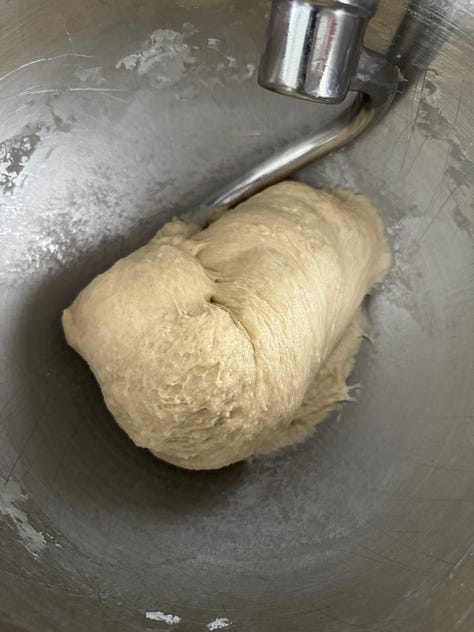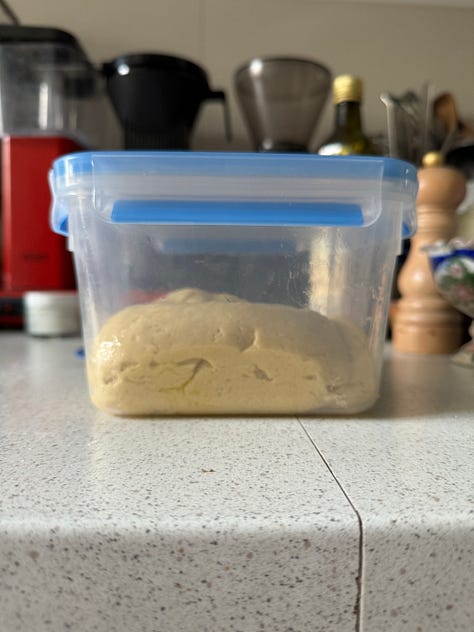One thing I realized after my son was born was just how much parental influence happens without any thought or effort. He mostly looks like I did at the same age, but he has his dad’s smile. When I stretch in the mornings, he bends over, plants his head on the yoga mat and sends his butt to the sky in a downward-facing dog. I call his hands “handies,” and now when he needs help up, he reaches out and says, “Handy!”
But there are other things that require intention. We’d like him to be curious about nature, so we take long walks, smell flowers, look at bugs, listen for birds. We’d like him to love food, so when I cook, I show him what I’m doing and give him tastes as we go. We’d like him to enjoy music, so my husband sits with him at the piano, playing chords, encouraging him to plonk along. And we’d like him to feel that he’s part of a Jewish family, so on Friday evenings, we light candles, drink grape juice, and eat challah to mark Shabbat.
I start the challah dough the day before. I love the braiding, and I try to make each week’s loaf prettier than the last. Many recipes call for a flexible amount of flour, to be adjusted based on the feel of the dough. But I’m fixated on accuracy, so I set about creating a recipe that’s precise. The most important steps are the mixing and the proofing. Overmix, and the gluten will break down and your bread won’t hold its shape. Underproof, and your bread will be doughy when it's baked. But master these two areas, and you’ll have a perfect challah every single time. And there’s another delightful ritual that comes with baking challah every week: Saturday-morning French toast made with the leftover bread!
Challah
Makes one loaf
235 grams all-purpose flour
115 grams bread flour
55 grams sugar
7 grams fine salt
1 whole egg
40 grams olive oil (any vegetable oil will do, but I like the extra fruitiness of olive)
110 grams water
14 grams fresh yeast (or 7 grams dried)
Equipment:
Stand mixer with dough hook
Pastry brush
Tupperware box with lid (I use a square, 1.5-liter box)
Add the all-purpose flour, bread flour, sugar, salt, egg, and oil to the bowl of a stand mixer fitted with a dough hook. Start the mixer on a low speed to begin mixing.
Gently heat the water in a small pan, taking care not to let it get hot. Lukewarm is perfect. Crumble in the fresh yeast (or add the dried) and stir until it dissolves completely.
Keep the mixer on a low speed and slowly drizzle in the water and yeast mixture. Increase the speed to medium-slow, and knead for four minutes. Reduce the speed to low for a further four minutes. The dough will be soft and stretchy and slightly tacky.



Transfer the dough to an oiled Tupperware box and cover with a lid. Leave to rise until the dough has doubled in volume.
Transfer the dough to a slightly oiled surface and knock the air out. Form into a ball and return to the oiled box.
Leave to rise until it has doubled in volume again, then knock it back again. Return the dough to the oiled box, set in the fridge, and leave overnight.
The dough will rise a bit in the fridge, so transfer it to a floured surface and knock the air out with the heel of your hand. Divide the dough into six equal pieces (roughly 100–105 grams per piece).



Elongate each piece by gently stretching it, then set it down horizontally in front of you. Take the top long edge and fold it over so it doesn’t quite meet the bottom long edge. Press it down with your fingers. Then use the palms of your hand to roll it into a sausage about 33 centimeters long (it’ll shrink slightly). Set to the side on a well-floured surface. Repeat with the remaining five pieces.



On a well-floured surface, arrange your dough strands vertically in front of you, and pinch the top ends together. Mentally number them 1–6, from left to right. Take strand 6 and cross it over all the other strands, laying it down so it is horizontally above strand 1. Take strand 1, and do the same, crossing it over the other strands, and lay it horizontally above strand 5.


Renumber the strands 1–6, from left to right. Take strand 1 and cross it over 2 and 3, then lay it down between 3 and 4. Take strand 5 and cross it over strands 4, 1, 3, and 2, and lay it horizontally above strand 2. Renumber the strands 1–6 in their new positions.


Take strand 6 and cross it over 4 and 5, then lay it down between 3 and 4. Take strand 2 and cross it over 3, 6, 4, and 5, and lay it horizontally above strand 5.


Repeat the above process, alternating between left and right (starting with strand 1 or strand 6) until you have braided the whole loaf. When the ends of the strands are too short to braid further, press them all together to seal, then tuck under the loaf.

Transfer your braid to a baking sheet lined with baking paper. Apply a layer of egg wash to the loaf, then cover with an oiled piece of cling film. Allow to rise in a warm place until it doubles in volume. The loaf should jiggle slightly when you shake the tray.
Preheat the oven to 190°C (with fan). Gently apply a second layer of egg wash, then bake in the oven for 30 minutes. I usually cover the loaf with foil after 15 minutes to avoid the crust baking too dark.
Allow the loaf to cool before serving.
Recipe notes:
If you don’t have a stand mixer, you can knead the dough by hand. It will take a bit longer and be rather messy at the beginning, but it will work just fine.
You don’t have to make a six-braided challah on your first attempt. You can simply divide the dough in three and make a basic braid.
If I have egg yolks to use up, I often add an extra egg yolk to the dough. It will make it slightly stickier and thus a bit more tricky to handle.
You don’t have to start the day before. The dough is a bit easier to handle when it has been refrigerated, but if you want to bake your challah the same day you make the dough, just start early. You can have a challah baked in time for dinner.







There’s so much love in smelling the flowers (Miley even buys them for herself!) ♥️